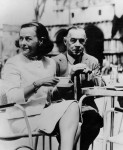 Two rare Egyptian mummy portraits with a dramatic history will be sold at Christie’s Antiquities auction in New York on October 25th. One is an encaustic on wood portrait of a woman, identifiable from her hairstyle (a single braid wrapped around her head) and earrings as dating to the 2nd century A.D.; the other, also encaustic on wood, is a portrait of a bearded man from the 2nd century A.D. The pre-sale estimate for the woman is $150,000-250,000, for the man $100,000-150,000.
Two rare Egyptian mummy portraits with a dramatic history will be sold at Christie’s Antiquities auction in New York on October 25th. One is an encaustic on wood portrait of a woman, identifiable from her hairstyle (a single braid wrapped around her head) and earrings as dating to the 2nd century A.D.; the other, also encaustic on wood, is a portrait of a bearded man from the 2nd century A.D. The pre-sale estimate for the woman is $150,000-250,000, for the man $100,000-150,000.
 They are being offered for sale by the Mosse Art Restitution Project which represents the heirs of Rudolf Mosse (1843-1920), a German Jewish publisher and philanthropist who amassed an extensive collection of art and antiquities in his lifetime. The portraits were part of that collection, probably acquired thanks to his sponsorship of archaeological excavations by German Egyptologist Heinrich Karl Brugsch. Brugsch died in 1894, so if the portraits did come through him, they left Egypt legally in the 19th century which is not something you see every day with mummy portraits.
They are being offered for sale by the Mosse Art Restitution Project which represents the heirs of Rudolf Mosse (1843-1920), a German Jewish publisher and philanthropist who amassed an extensive collection of art and antiquities in his lifetime. The portraits were part of that collection, probably acquired thanks to his sponsorship of archaeological excavations by German Egyptologist Heinrich Karl Brugsch. Brugsch died in 1894, so if the portraits did come through him, they left Egypt legally in the 19th century which is not something you see every day with mummy portraits.
Mosse published the liberal newspaper the Berliner Tageblatt. After his death, his daughter Felicia’s husband Hans Lachmann-Mosse took over as publisher. When the Nazis came on the scene, the newspaper under editor-in-chief Theodor Wolff was heavily critical of them. Then came February 1933, the Reichstag fire and the quick series of legislative changes that instituted single party rule and suspended civil liberties. In the beginning of March, 1933, Hans Lachmann-Mosse succumbed to pressure to take Wolff off the masthead and drastically shift the direction of the paper to the political right. Wolff, who was Jewish (he was Rudolf Mosse’s cousin, in fact), liberal and the founder of one of the parties that would soon be outlawed, had already fled by then, taking off for Austria the day after the fire.
 Hans’ efforts to go with the flow were wasted, of course. He and Felicia were forced to flee, leaving the great Mosse collection behind to be preyed upon by Nazi art gluttons. The collection was confiscated by the state and sold at auction. The Egyptian portraits were acquired by none other than Erich Maria Remarque, author of the classic World War I novel, All Quiet on the Western Front.
Hans’ efforts to go with the flow were wasted, of course. He and Felicia were forced to flee, leaving the great Mosse collection behind to be preyed upon by Nazi art gluttons. The collection was confiscated by the state and sold at auction. The Egyptian portraits were acquired by none other than Erich Maria Remarque, author of the classic World War I novel, All Quiet on the Western Front.
The Nazis hated Erich Maria Remarque. Even before the Nazi takeover of Germany, Joseph Goebbels excoriated Remarque’s novel and dispatched Hitler Youth to cause gross disruptions — releasing large numbers of mice, throwing stink bombs — in theaters showing the extremely popular and critically acclaimed Hollywood movie of the book. Remarque was derided as a crypto-Jew (he was Catholic from a long line of Catholics), a Marxist (he wasn’t even a leftist, just a pacifist) and a coward who hadn’t even seen combat in World War I (he was wounded on the Western Front, taking shrapnel in his leg, back and neck). Remarque’s books were officially banned on May 10th, 1933, just over two months after the passage of the Reichstag Fire Decree that all but abolished civil liberties. He was burned in effigy in front of Berlin’s opera house, and his books were thrown on the great bonfire alongside those of James Joyce, Ernest Hemingway, Albert Einstein and Thomas Mann.
 Remarque moved to his villa in Switzerland. His collection of art and Egyptian antiquities, now including the two Mosse mummy portraits, went with him. After his death in 1970, his collection passed to his wife Paulette Goddard-Remarque, famous in her own right as a silent movie actress and Charlie Chaplin’s ex-wife who starred in with him in Modern Times and, in a lovely middle finger to Hitler, in The Great Dictator. She sold the portraits to the University of Zurich. Researchers at the university identified them last year as having been part of the Mosse collection and they were restituted to the foundation.
Remarque moved to his villa in Switzerland. His collection of art and Egyptian antiquities, now including the two Mosse mummy portraits, went with him. After his death in 1970, his collection passed to his wife Paulette Goddard-Remarque, famous in her own right as a silent movie actress and Charlie Chaplin’s ex-wife who starred in with him in Modern Times and, in a lovely middle finger to Hitler, in The Great Dictator. She sold the portraits to the University of Zurich. Researchers at the university identified them last year as having been part of the Mosse collection and they were restituted to the foundation.
 This kind of deep background is unusual for mummy portraits, not just because there are celebrities involved, but because when they crop up in the market, they often have very little in the way of documented history. For instance, this exquisitely beautiful portrait of a woman from ca. 55-70 A.D. that sold at Christie’s in 2006 for $262,400 has a single line in the Provenance category: “Thierry Cambelong, Switzerland, 1970s.” It’s every art dealer’s favorite mythical Canadian girlfriend, the Swiss private collection vaguely dated to the 1970s so it won’t fall afoul of the UNESCO Convention on the Means of Prohibiting and Preventing the Illicit Import, Export and Transfer of Ownership of Cultural Property. Interestingly enough, if you Google “Thierry Cambelong,” all you get are four entries from antiquities auctions. This mummy portrait of a striking young man from ca. 80-140 A.D. has even less to go on in terms of ownership history. There is no provenance category at all, only a reference to it having been published in a 1999 book on Romano-Egyptian funerary art.
This kind of deep background is unusual for mummy portraits, not just because there are celebrities involved, but because when they crop up in the market, they often have very little in the way of documented history. For instance, this exquisitely beautiful portrait of a woman from ca. 55-70 A.D. that sold at Christie’s in 2006 for $262,400 has a single line in the Provenance category: “Thierry Cambelong, Switzerland, 1970s.” It’s every art dealer’s favorite mythical Canadian girlfriend, the Swiss private collection vaguely dated to the 1970s so it won’t fall afoul of the UNESCO Convention on the Means of Prohibiting and Preventing the Illicit Import, Export and Transfer of Ownership of Cultural Property. Interestingly enough, if you Google “Thierry Cambelong,” all you get are four entries from antiquities auctions. This mummy portrait of a striking young man from ca. 80-140 A.D. has even less to go on in terms of ownership history. There is no provenance category at all, only a reference to it having been published in a 1999 book on Romano-Egyptian funerary art.
I must say that the artists showed remarkable painting skills.
They really did. Very little realistic portraiture survives from antiquity, but these people look like they could step off the panels and breathe.
“2st century A.D.”
Fixed, thank you very much. :thanks:
Wonderful portraits. I love them all.
Me too. I don’t often find such wonderfully large photographs of mummy portraits. In this pictures you can see the artistry in so much detail. The eyelashes slay me.
Is it known if this style of “realistic” painting was used in other instance in egypt? I mean, not for the dead/mummies.
The writing sistem is flat, the painting codes are mostly derivated from it, and I was wondering if the ‘volumic’ painting style was strictly restricted to the representation of the deads, through the different times of egypt?
Because thats quite an artistic and brain stretch to do, between a hieroglyphic representation and these ones, if you only paint a dead every two months.
Has it been documentated as a commun practice made in the prime years of the upper class individuals? Busy today, haircut, makeup, and me mummy portrait with JS Sargent?